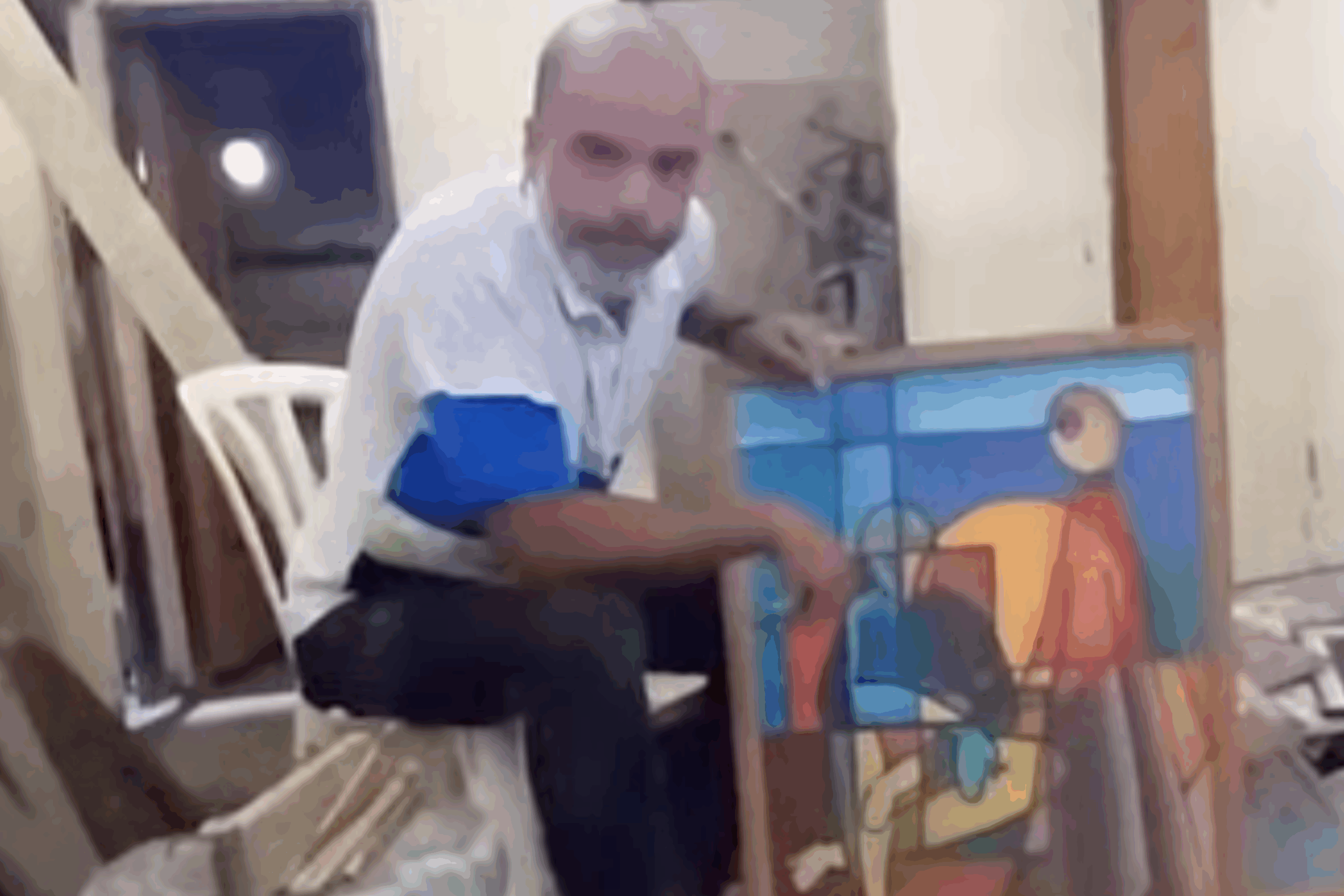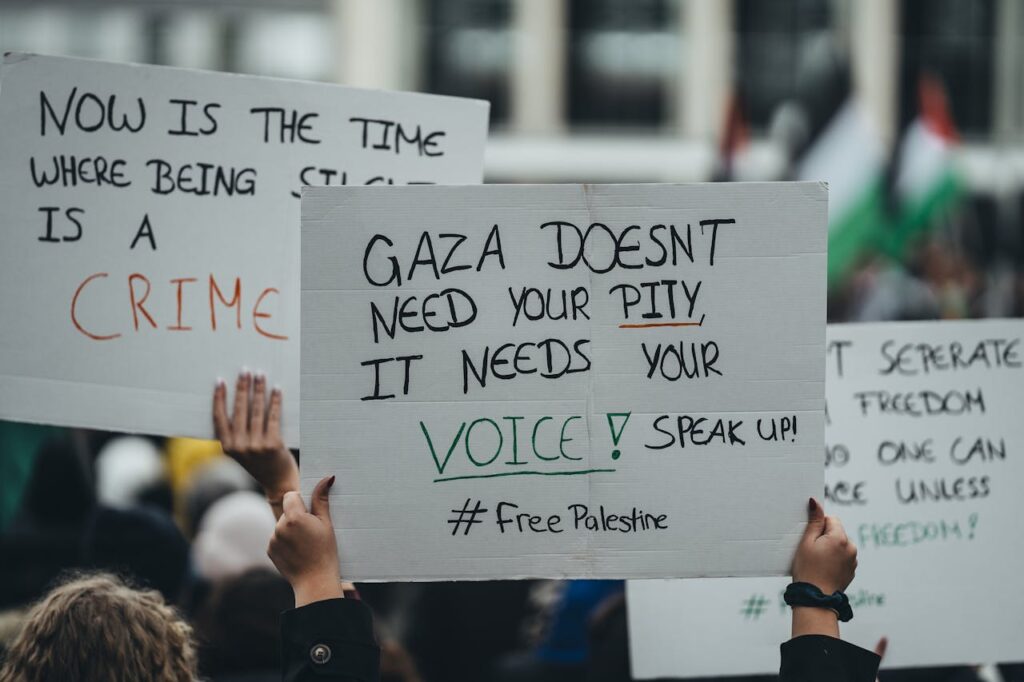Watch: Palestinian Artist Destroys His Own Paintings So He Could Use Them as Firewood to Cook Food for His Children in Gaza

When war breaks out, the world counts bodies and broken buildings. But what rarely makes the headlines are the quieter losses—the warmth of a home, the taste of a shared meal, the joy of creating something beautiful. In Gaza, these losses stack up every day. One artist, faced with the cold, fed his fire with his own paintings. In those flames burned not just paint and canvas, but years of dreams and self-expression. It’s a truth we often forget: in war, people don’t just lose their lives, they lose the very things that make life worth living.
When Art Becomes Fuel: Survival in Gaza
In Gaza, survival has a way of forcing impossible decisions. For Palestinian artist Taha Hussein Abu Ghali, that decision meant taking apart the very works that once defined his life. In a small, dimly lit room, he removes each canvas from its frame—portraits of children, abstract swirls of color, entire stories painted in strokes of hope. The wood is broken down, piece by piece, to feed the fire.
A video of the moment shows the quiet devastation of the act. As his wife tends a small pot over the flames, Abu Ghali’s voice is steady but heavy. “We cannot find flour or anything to cook with. These are some of my favorite paintings, portraits of children, colors, and stories. All gone, burned to survive,” he says.
For him, each piece carried hours of labor, moments of inspiration, and a part of his identity. Now, in a city under blockade where 2.2 million residents face crippling shortages, even the most personal expressions of beauty become a resource for staying alive. His choice reflects the shared reality of countless families here—lives pared down to nothing but the essentials.
International aid agencies including Doctors Without Borders, Save the Children, and Oxfam have issued stark warnings of worsening hunger across Gaza. The director general of the World Health Organization, Tedros Adhanom Ghebreyesus, put it plainly: he does not know what else to call it but “mass starvation,” a crisis he emphasizes is entirely man-made.
Abu Ghali’s decision is more than an act of necessity—it is a quiet, powerful statement about what war truly takes. Beyond the loss of safety and shelter, it robs people of the very things that give life meaning. In his fire, art is not destroyed out of disdain, but sacrificed so that life, for another day, might continue.
Taha Hussein Abu Ghali: Painting Against the Darkness
Before the flames, there was a lifetime of color. Taha Hussein Abu Ghali’s journey began at Al Aqsa University in Gaza, where he developed a distinctive voice in figurative surrealism—blending abstract and cubist elements to capture identity, childhood, and memory on canvas. His art wasn’t just decorative; it was a mirror, reflecting the emotional reality of life under siege.
Outside his own work, Abu Ghali became a teacher and community mentor, guiding students not only in technique but in using art as therapy—a means to confront and process trauma. In a place where hope is fragile, he held space for it to exist.
His studio was a sanctuary. Here, color bloomed against a backdrop of scarcity and unrest. Every painting required hours of meticulous work, often created under the pressure of limited materials and interrupted days. In Gaza, to keep creating under these conditions is not simply an act of artistry—it is defiance. And for years, Abu Ghali’s defiance took the form of paintings that spoke louder than the conflict surrounding them.
Gaza on the Brink: A Crisis Beyond Survival
When Taha Hussein Abu Ghali fed his fire with his own art, it was not just a personal tragedy. It was a symbol of a much larger disaster. Across Gaza, survival has become a daily negotiation between hunger, displacement, and the collapse of basic infrastructure. Every choice carries a cost, often paid in dignity and culture.
The numbers are staggering. According to the British Red Cross and the Palestine Red Crescent Society (PRCS), 470,000 people, roughly 22 percent of Gaza’s population, are on the brink of starvation. Cases of severe child malnutrition are rising fast. In Rafah, field hospitals report treating infants so weak they collapse while sleeping. Medics perform up to 40 emergency procedures a day, often without enough medicine, fuel, or even food to sustain their work. With 70 percent of Gaza’s water infrastructure destroyed, many families drink contaminated water, triggering outbreaks of hepatitis, diarrhea, and other preventable illnesses.
In the north, the situation is even more dire. BBC reporting has shown families grinding animal feed into flour just to survive, while others have nothing but rice. Mahmoud Shalabi, a medical aid worker in Beit Lahia, described the reality: “What we had was actually from the six or seven days of truce [in November], and whatever aid was allowed into the north of Gaza has actually been consumed by now. What people are eating right now is basically rice, and only rice.”
Daily survival often means walking miles in search of the basics. One mother traveled six miles after her children went three days without food. Others dig through rubble to reach broken water pipes. The World Food Programme warns that without regular, secure aid deliveries, famine is almost inevitable. As WFP regional chief Matt Hollingworth put it, “We know there is a very serious risk of famine in Gaza if we don’t provide very significant volumes of food assistance on a regular basis.”
But reaching those in need is fraught with obstacles. Missions to northern Gaza are often denied, leaving 300,000 residents cut off from lifesaving support. Convoys face weeks-long delays or shelling nearby. Hospital stocks are collapsing, 47 percent of essential medications are gone, and treatments for chronic diseases have completely run out. Since the escalation began, more than 52,000 people have been killed and 118,000 injured. Ninety percent of the population has been displaced, many multiple times, as field hospitals overflow and mass-casualty incidents multiply.
Israeli authorities reject claims of famine, saying there is “no starvation in Gaza” and attributing shortages to Hamas. Yet the World Health Organization and multiple humanitarian organizations call the situation “man-made mass starvation” and stress that unrestricted, consistent aid is the only way to stop it from becoming a full-scale famine.
How You Can Support Gaza’s People
It is easy to feel powerless in the face of a crisis this vast, but change often begins with small, deliberate acts. You may be thousands of miles away, yet your choices can ripple into places you may never see.

- Support trusted humanitarian organizations
Donate to established groups like the World Food Programme, Doctors Without Borders, or Save the Children, which have verified operations in the region. Your contribution can help provide food, medical care, and clean water directly to those in need. - Use your voice
Share verified news and stories from credible sources on social media. Raising awareness keeps pressure on decision-makers and ensures the crisis is not forgotten. - Participate in local fundraisers
Look for community events, charity art sales, or school drives that support relief work in Gaza. Collective local action can raise significant funds and awareness. - Advocate for policy change
Contact your elected representatives to express support for consistent humanitarian aid access to Gaza. Public advocacy can help influence government action. - Stay informed
Follow updates from reputable news outlets and humanitarian organizations. Understanding the situation helps you share accurate information and avoid misinformation.
Every voice, every contribution, every moment of attention matters. Alone, the impact may seem small. Together, it can mean warmth instead of cold, food instead of hunger, and hope instead of despair.
When Survival Burns the Soul: Gaza’s Art, Hunger, and Humanity
Taha Hussein Abu Ghali’s fire burned more than wood and paint. It burned a piece of Gaza’s culture, a fragment of its memory, and a reminder that in war, beauty often becomes the first casualty. His story is one among thousands, each shaped by impossible choices no one should ever have to make.
The crisis in Gaza is not an abstract headline. It is children falling asleep hungry, mothers walking miles for food, and artists sacrificing their life’s work for a single meal. It is a reality that demands not just sympathy, but action.
We may not all hold the power to stop the violence, but we each hold the power to respond. To give, to speak, to share, to refuse to look away. Because when enough people choose to act, even the smallest gestures can ignite hope—and hope, in places like Gaza, is as vital as bread and water.
Featured Image from @art_taha_husien on Instagram
Loading...

